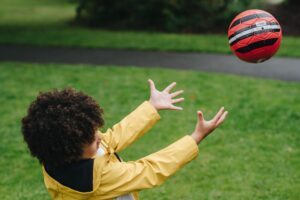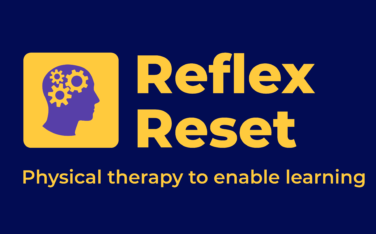What is the STNR?
The STNR is triggered by neck position and flexion/extension of the head. Unlike the TLR, the STNR does not cause a whole-body response of flexion/extension but the reflex separates the body into two halves at the waist – two opposite patterns of movement happen to the top and bottom halves of the body. When the chin lifts, the arms go into extension/straighten and the hips and legs flex/bend; conversely, when the head goes down the arms flex/bend and the legs extend/straighten. The STNR is beautifully demonstrated by a toddler standing in his cot – his mother comes to lift him out and he looks up and raises his arms and promptly sits down because his lower limbs have gone into flexion.
What is the purpose of the STNR?
The purpose of the STNR is to inhibit the TLR and allow the child to get into a position to creep or crawl. This is seen when a child raises his head and shoulders when in prone/on his tummy – his arms extend and knees and hips flex and this helps him get onto his hands and knees. The STNR is inhibited by crawling because this is a movement in which the limbs must move contra-laterally/in opposites and independently of head position. The rocking movement, used by infants as they attempt to crawl, is thought to help break down the STNR.
By the time the STNR appears, the child should be able to sit unaided; he is rolling and getting himself into sitting. The strength in his legs is improving – his legs are always behind his arms due to the cephalo-caudal (head to toe) sequence of development. Now he wants to stand. He will use the STNR to help him get up from sitting to standing. If he keeps his head down and arms bent as he pulls upwards, his legs will extend, helping him upright.
The STNR is also thought to help develop visual accommodation – the ability to maintain a clear image of an object as its distance changes. The ATNR has assisted in focusing to arm’s length. Now the STNR in flexion brings the focus back to near distance (between the knees) and, as the head is lifted and the STNR in extension established, the focus is moved to far distance.
What happens if the STNR is retained?
– Poor posture
One of the more obvious signs of a retained STNR is seen in the posture, both active and static. If the STNR pattern has not been inhibited, head position will still affect the tone of the upper and lower body differently. When walking, the gait may have simian/monkey-like quality. In standing, the posture is slouched with shoulders rounded and the chin forward. In sitting on the floor, a child may adopt a ‘W’ position. Sitting cross-legged on the floor is almost impossible if the STNR is strong because, with the head flexed/bent, the legs want to be extended/straight. Sitting on a chair at a desk also causes problems because again, if the arms are flexed/bent and the chin down, the legs want to be straight. The child may end up lying on his desk when writing. He may also tuck his feet under his bottom or hook his feet round the legs of the chair to lock his legs and keep them ‘under control’.
– Poor concentration and attention
As a result of the issues caused by posture, a STNR child may have problems with concentration and attention. He may appear to be fidgety and unable to sit still, all because it is too uncomfortable to be so.
– Difficulty catching a ball and copying
A retained STNR will have effects on vision; on accommodation and also on vertical tracking. The child may find actions like catching a ball difficult, as his ability to focus correctly on a moving object (especially one moving towards him) may be compromised. He will also find it awkward to copy from a blackboard or white board as switching from far to near vision quickly will be slower for him than that of his peer group. Vertical tracking, where the eyes move from top to bottom, has been shown to be impaired in STNR children. This affects tasks such as lining up information or numbers in columns and can lead to trouble assessing height, such as walking onto a descending escalator or when standing on the edge of a diving board or cliff.
A child with a retained STNR may be a messy eater and end up wearing his food rather than getting it into his mouth. He may also find swimming a challenge – whenever he raises his head above the water his lower limbs will bend, so this is a child who likes to swim under water.
